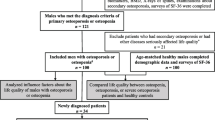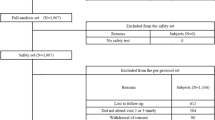Abstract
We investigated changes in quality of life (QOL), including pain, in Japanese women aged ≥ 55 years who were diagnosed as having osteoporosis at 265 centers across Japan and treated continuously with once-weekly bisphosphonates for 24 months. In 2650 evaluable patients, a significant improvement in QOL was observed from 3 months after enrollment onward and maintained throughout the 2-year observation period. A significant improvement in scores was observed for all domains of the Euro QOL 5 Dimension (EQ-5D), and the “pain”, “health perception”, and “posture, figure” domains of the Japanese Osteoporosis QOL Questionnaire (JOQOL). Factors identified as significantly contributing to QOL change were “fractures within the year before enrollment”, “presence of spondylosis deformans”, “presence of osteoarthritis”, “use of activated vitamin D3”, and “age” based on the JOQOL, and “presence of spondylosis deformans”, “use of activated vitamin D3”, and “age” based on the EQ-5D. The results suggested that the patients’ perception of treatment effects, such as improvement in pain, contributes to treatment continuation. Osteoporosis patients should be informed that continuous treatment with once-weekly bisphosphonates can lead to a significant improvement in QOL regardless of concomitant locomotor diseases, to encourage them to remain on treatment. In conclusion, continuous bisphosphonate treatment improved the QOL even in patients with locomotor diseases, and the concomitant use of activated vitamin D3 may also facilitate further improvement in QOL.




Similar content being viewed by others
References
Yoshimura N, Muraki N, Oka H, Kawaguchi H, Nakamura K, Akune T (2010) Cohort profile: research on Osteoarthritis/Osteoporosis Against Disability study. Int J Epidemiol 39:988–995
Yoshimura N, Muraki S, Oka H, Mabuchi A, En-Yo Y, Yoshida M, Saika A, Yoshida H, Suzuki T, Yamamoto S, Ishibashi H, Kawaguchi H, Nakamura K, Akune T (2009) Prevalence of knee osteoarthritis, lumbar spondylosis, and osteoporosis in Japanese men and women: the research on osteoarthritis/osteoporosis against disability study. J Bone Miner Metab 27:620–628
Committee for the Development of Guidelines for Prevention and Treatment of Osteoporosis (Japan Osteoporosis Society, The Japanese Society for Bone and Mineral Research and Japan Osteoporosis Foundation) (2015) Guidelines for prevention and treatment of osteoporosis (in Japanese). Life Science Publishing Co., Ltd., Tokyo
Kumamoto K, Nakamura T, Suzuki T, Gorai I, Fujinawa O, Ohta H, Shiraki M, Yoh K, Fujiwara S, Endo N, Matsumoto T (2010) Validation of the Japanese Osteoporosis Quality of Life Questionnaire. J Bone Miner Metab 28:1–7
Hagino H, Sawaguchi T, Endo N, Ito Y, Nakano T, Watanabe Y (2012) The risk of a second hip fracture in patients after their first hip fracture. Calcif Tissue Int 90:14–21
Tsukutani Y, Hagino H, Ito Y, Nagashima H (2015) Epidemiology of fragility fractures in Sakaiminato, Japan: incidence, secular trends, and prognosis. Osteoporos Int 26:2249–2255
Kamatari M, Koto S, Ozawa N, Urao C, Suzuki Y, Akasaka E, Yanagimoto K, Sakota K (2007) Factors affecting long-term compliance of osteoporotic patients with bisphosphonate treatment and QOL assessment in actual practice: alendronate and risedronate. J Bone Miner Metab 25:302–309
Adler RA, El-Hajj Fuleihan G, Bauer DC, Camacho PM, Clarke BL, Clines GA, Compston JE, Drake MT, Edwards BJ, Favus MJ, Greenspan SL, McKinney R Jr, Pignolo RJ, Sellmeyer DE (2016) Managing osteoporosis in patients on long-term bisphosphonate treatment: report of a Task Force of the American Society for Bone and Mineral Research. J Bone Miner Res 31:16–35
Kanis JA, Johnell O, Oden A, Johansson H, McCloskey E (2008) FRAX and the assessment of fracture probability in men and women from the UK. Osteoporos Int 19:385–397. https://doi.org/10.1007/s00198-007-0543-5
Orimo H, Nakamura T, Fukunaga M, Ohta H, Hosoi T, Uemura Y, Kuroda T, Miyakawa N, Ohashi Y, Shiraki M, A-TOP (Adequate Treatment of Osteoporosis) Research Group (2011) Effects of alendronate plus alfacalcidol in osteoporosis patients with a high risk of fracture: the Japanese Osteoporosis Intervention Trial (JOINT)—02. Curr Med Res Opin 27:1273–1284
Nakamura T, Osawa M, Itoh M, Yamaguchi H, Iinuma N, Hayakawa Y, Suzuki H, Kamisaki T, Iwayama S, Nishikawa M (2012) The effect of risedronate (17.5 mg/week) treatment on quality of life in Japanese women with osteoporosis: a prospective observational study. J Bone Miner Metab 30:715–721
Ohta H, Uemura Y, Nakamura T, Fukunaga M, Ohashi Y, Hosoi T, Mori S, Sugimoto T, Itoi E, Orimo H, Shiraki M, Adequate Treatment of Osteoporosis (A-TOP) Research Group (2014) Serum 25-hydroxyvitamin D level as an independent determinant of quality of life in osteoporosis with a high risk for fracture. Clin Ther 36:225–235
Carmel AS, Shieh A, Bang H, Bockman RS (2012) The 25(OH)D level needed to maintain a favorable bisphosphonate response is ≥ 33 ng/ml. Osteoporos Int 23:2479–2487
Institute of Medicine, Food and Nutrition Board (2010) Dietary reference intakes for calcium and vitamin D. National Academy Press, Washington, DC
Fujikawa A, Suzue T, Jitsunari F, Hirao T (2011) Evaluation of health-related quality of life using EQ-5D in Takamatsu, Japan. Environ Health Prev Med 16:25–35
Acknowledgements
The authors thank all investigators who participated in this study.
Author information
Authors and Affiliations
Corresponding author
Ethics declarations
Conflict of interest
This study was funded by the Japan Association of Health Service.
Ethical approval
All procedures performed in studies involving human participants were in accordance with the ethical standards of the institutional and/or national research committee and with the 1964 Helsinki declaration and its later amendments or comparable ethical standards.
Electronic supplementary material
Below is the link to the electronic supplementary material.
About this article
Cite this article
Hagino, H., Soen, S., Sugimoto, T. et al. Changes in quality of life in patients with postmenopausal osteoporosis receiving weekly bisphosphonate treatment: a 2-year multicenter study in Japan. J Bone Miner Metab 37, 273–281 (2019). https://doi.org/10.1007/s00774-018-0914-3
Received:
Accepted:
Published:
Issue Date:
DOI: https://doi.org/10.1007/s00774-018-0914-3




